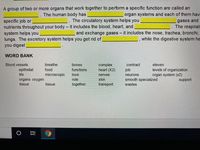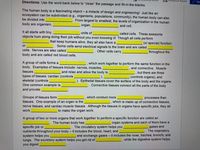
Human Anatomy & Physiology (11th Edition)
11th Edition
ISBN: 9780134580999
Author: Elaine N. Marieb, Katja N. Hoehn
Publisher: PEARSON
expand_more
expand_more
format_list_bulleted
Question
thumb_up100%
Overview of the human body

Transcribed Image Text:A group of two or more organs that work together to perform a specific function are called an
organ systems and each of them have
The human body has
The circulatory system helps you
specific job or
nutrients throughout your body - it includes the blood, heart, and
system helps you
lungs. The excretory system helps you get rid of,
you digest
gases and
The respirat
and exchange gases - it includes the nose, trachea, bronchi,
while the digestive system he
WORD BANK
Blood vessels
breathe
bones
complex
heart (X2)
contract
eleven
levels of organization
organ system (x2)
support
epithelial
food
functions
job
life
microscopic
love
nerves
neurons
role
skin
smooth specialized
organs oxygen
tissue
tissue
together
transport
wastes
近

Transcribed Image Text:EP Immersive Reader
Directions: Use the word bank below to "close" the passage and fill-in-the-blanks.
Ope
The human body is a fascinating object – a miracle of design and engineering! Just like an
ecosystem can be subdivided (e.g.., organisms, populations, community), the human body can also
be divided into
From largest to smallest, the levels of organization in the human
body are organism,
organ,
and cell.
It all starts with tiny,
units of
objects hum along doing their job without you even knowing it! Though all cells perform
called cells. These awesome
that keep humans alive, they all also have a
Some cells send electrical signals to the brain and are called
(or special) function
or
cells. Nerves are also called
Other cells carry
throughout the
body and are called red blood cells.
A group of cells forms a
body. Examples of tissues include: nerves, muscles,
which work together to perform the same function in the
and connective. Muscle
tissues
and relax and allow the body to
but there are three
types of tissues: cardiac (controls
skeletal (controls
One common example is
and provide
(controls organs), and
). Epithelial tissues cover the surface of the body and the organs.
Connective tissues connect all the parts of the body
which conduct more
Groups of tissues form
tissues. One example of an organ is the
nerve tissues, and cardiac muscle tissues. Although the tissues in organs have specific jobs, they all
processes than
which is made up of connective tissues,
work
to make the organ work.
A group of two or more organs that work together to perform a specific function are called an
The human body has
organ systems and each of them have a
The circulatory system helps you
specific job or
nutrients throughout your body – it includes the blood, heart, and
system helps you
lungs. The excretory system helps you get rid of
you digest
gases and
The respiratory
and exchange gases - it includes the nose, trachea, bronchi, and
while the digestive system helps
Expert Solution
This question has been solved!
Explore an expertly crafted, step-by-step solution for a thorough understanding of key concepts.
This is a popular solution
Trending nowThis is a popular solution!
Step by stepSolved in 2 steps

Knowledge Booster
Similar questions
- Answer this following question in your own words? question 1: Name the 4 quadrants and 9 body regions of the human body, and Why is it important to know these quadrants and regions? question 2: Define the following terms: gross anatomy microscopic anatomy macroscopic anatomy regional anatomy systemic anatomy physiologyarrow_forwardusing the key choose the organ system to which each of the following sets of organs or body structures belongsarrow_forwardwhy is learning the reigions of the body with their proper terminology important? how is the understanding of the directional terminology important to those in the healthcare field? the body is structurally organized into level-choose one level and briefly which system of the body are you most looking forward to learn and why?arrow_forward
arrow_back_ios
SEE MORE QUESTIONS
arrow_forward_ios
Recommended textbooks for you
 Human Anatomy & Physiology (11th Edition)BiologyISBN:9780134580999Author:Elaine N. Marieb, Katja N. HoehnPublisher:PEARSON
Human Anatomy & Physiology (11th Edition)BiologyISBN:9780134580999Author:Elaine N. Marieb, Katja N. HoehnPublisher:PEARSON Biology 2eBiologyISBN:9781947172517Author:Matthew Douglas, Jung Choi, Mary Ann ClarkPublisher:OpenStax
Biology 2eBiologyISBN:9781947172517Author:Matthew Douglas, Jung Choi, Mary Ann ClarkPublisher:OpenStax Anatomy & PhysiologyBiologyISBN:9781259398629Author:McKinley, Michael P., O'loughlin, Valerie Dean, Bidle, Theresa StouterPublisher:Mcgraw Hill Education,
Anatomy & PhysiologyBiologyISBN:9781259398629Author:McKinley, Michael P., O'loughlin, Valerie Dean, Bidle, Theresa StouterPublisher:Mcgraw Hill Education, Molecular Biology of the Cell (Sixth Edition)BiologyISBN:9780815344322Author:Bruce Alberts, Alexander D. Johnson, Julian Lewis, David Morgan, Martin Raff, Keith Roberts, Peter WalterPublisher:W. W. Norton & Company
Molecular Biology of the Cell (Sixth Edition)BiologyISBN:9780815344322Author:Bruce Alberts, Alexander D. Johnson, Julian Lewis, David Morgan, Martin Raff, Keith Roberts, Peter WalterPublisher:W. W. Norton & Company Laboratory Manual For Human Anatomy & PhysiologyBiologyISBN:9781260159363Author:Martin, Terry R., Prentice-craver, CynthiaPublisher:McGraw-Hill Publishing Co.
Laboratory Manual For Human Anatomy & PhysiologyBiologyISBN:9781260159363Author:Martin, Terry R., Prentice-craver, CynthiaPublisher:McGraw-Hill Publishing Co. Inquiry Into Life (16th Edition)BiologyISBN:9781260231700Author:Sylvia S. Mader, Michael WindelspechtPublisher:McGraw Hill Education
Inquiry Into Life (16th Edition)BiologyISBN:9781260231700Author:Sylvia S. Mader, Michael WindelspechtPublisher:McGraw Hill Education

Human Anatomy & Physiology (11th Edition)
Biology
ISBN:9780134580999
Author:Elaine N. Marieb, Katja N. Hoehn
Publisher:PEARSON

Biology 2e
Biology
ISBN:9781947172517
Author:Matthew Douglas, Jung Choi, Mary Ann Clark
Publisher:OpenStax

Anatomy & Physiology
Biology
ISBN:9781259398629
Author:McKinley, Michael P., O'loughlin, Valerie Dean, Bidle, Theresa Stouter
Publisher:Mcgraw Hill Education,

Molecular Biology of the Cell (Sixth Edition)
Biology
ISBN:9780815344322
Author:Bruce Alberts, Alexander D. Johnson, Julian Lewis, David Morgan, Martin Raff, Keith Roberts, Peter Walter
Publisher:W. W. Norton & Company

Laboratory Manual For Human Anatomy & Physiology
Biology
ISBN:9781260159363
Author:Martin, Terry R., Prentice-craver, Cynthia
Publisher:McGraw-Hill Publishing Co.

Inquiry Into Life (16th Edition)
Biology
ISBN:9781260231700
Author:Sylvia S. Mader, Michael Windelspecht
Publisher:McGraw Hill Education